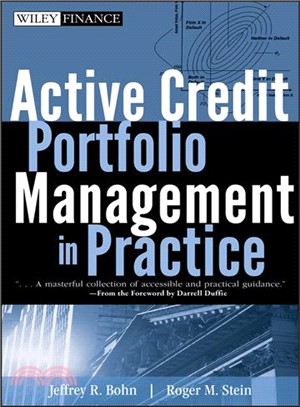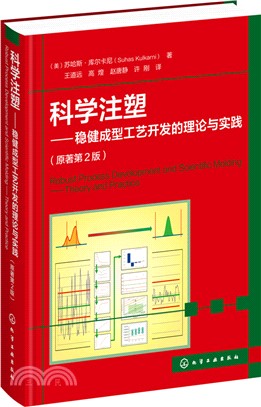Active Credit Portfolio Management In Practice
商品資訊
ISBN13:9780470080184
出版社:John Wiley & Sons Inc
作者:Bohn
出版日:2009/03/16
裝訂/頁數:精裝/640頁
規格:24.1cm*15.9cm*5.7cm (高/寬/厚)
商品簡介
作者簡介
目次
商品簡介
State-of-the-art techniques and tools needed to facilitate effective credit portfolio management and robust quantitative credit analysis
Filled with in-depth insights and expert advice, Active Credit Portfolio Management in Practice serves as a comprehensive introduction to both the theory and real-world practice of credit portfolio management. The authors have written a text that is technical enough both in terms of background and implementation to cover what practitioners and researchers need for actually applying these types of risk management tools in large organizations but which at the same time, avoids technical proofs in favor of real applications. Throughout this book, readers will be introduced to the theoretical foundations of this discipline, and learn about structural, reduced-form, and econometric models successfully used in the market today. The book is full of hands-on examples and anecdotes. Theory is illustrated with practical application. The authors' Website provides additional software tools in the form of Excel spreadsheets, Matlab code and S-Plus code. Each section of the book concludes with review questions designed to spark further discussion and reflection on the concepts presented.
Filled with in-depth insights and expert advice, Active Credit Portfolio Management in Practice serves as a comprehensive introduction to both the theory and real-world practice of credit portfolio management. The authors have written a text that is technical enough both in terms of background and implementation to cover what practitioners and researchers need for actually applying these types of risk management tools in large organizations but which at the same time, avoids technical proofs in favor of real applications. Throughout this book, readers will be introduced to the theoretical foundations of this discipline, and learn about structural, reduced-form, and econometric models successfully used in the market today. The book is full of hands-on examples and anecdotes. Theory is illustrated with practical application. The authors' Website provides additional software tools in the form of Excel spreadsheets, Matlab code and S-Plus code. Each section of the book concludes with review questions designed to spark further discussion and reflection on the concepts presented.
作者簡介
Jeffrey R. Bohn, PhD (Tokyo Japan, and San Francisco,CA) leads the Financial Strategies group at Shinsei Bank in Tokyo. Previously, he co-led Moody’s KMV’s (MKMV’s) Global Research group and led MKMV’s Credit Strategies group.
Roger M. Stein, PhD (New York, NY) is Group Managing Director at Moody’s where he leads the newly formed Moody’s Quantitative Research and Analytics group. Previously, he co-led MKMV’s Global Research group. Prior to that he led Moody’s Risk Management Services’ Research Group.
Roger M. Stein, PhD (New York, NY) is Group Managing Director at Moody’s where he leads the newly formed Moody’s Quantitative Research and Analytics group. Previously, he co-led MKMV’s Global Research group. Prior to that he led Moody’s Risk Management Services’ Research Group.
目次
Foreword.
Preface.
Acknowledgments.
Chapter 1. The Framework: Definitions and Concepts.
What Is Credit?
Evolution of Credit Markets.
Defining Risk.
A Word About Regulation.
What Are Credit Models Good For?
Active Credit Portfolio Management (ACPM).
Framework at 30,000 Feet.
Building Blocks of Portfolio Risk.
Using PDs in Practice.
Value, Price, and Spread.
Defining Default.
Portfolio Performance Metrics.
Data and Data Systems.
Review Questions.
Chapter 2. ACPM in Practice.
Bank Valuation.
Organizing Financial Institutions: Dividing into Two Business Lines.
Emphasis on Credit Risk.
Market Trends Supporting ACPM.
Financial Instruments Used for Hedging and Managing Risk in a Credit Portfolio.
Mark-To-Market and Transfer Pricing.
Metrics for Managing a Credit Portfolio.
Data and Models.
Evaluating an ACPM Unit.
Managing a Research Team.
Conclusion.
Review Questions.
Exercises.
Chapter 3. Structural Models.
Structural Models in Context.
A Basic Structural Model.
Black-Scholes-Merton (BSM).
Valuation.
Modifying BSM.
First-Passage Time: Black-Cox.
Practical Implementation: Vasicek-Kealhofer.
Stochastic Interest Rates: Longstaff-Schwartz.
Jump-Diffusion Models: Zhou.
Endogenous Default Barrier (Taxes and Bankruptcy Costs): Leland-Toft.
Corporate Transaction Analysis.
Liquidity.
Other Structural Approaches.
Conclusion.
Appendix 1. Derivation of Black-Scholes-Merton Framework for Calculating Distance-to-Default (DD).
Appendix 2. Derivation of Conversion of Physical Probability of Default (PD) to a Risk-Neutral Probability of Default (PDQ).
Review Questions.
Exercises.
Chapter 4. Econometric Models.
Discrete-Choice Models.
Early Discrete Choice Models: Beaver (1966) and Altman (1968).
Hazard Rate (Duration) Models.
Example of a Hazard Rate Framework for Predicting Default: Shumway (2001).
Hazard Rates versus Discrete Choice.
Practical Applications: Falkenstein, et al. (2000) and Dwyer and Stein (2004).
Calibrating Econometric Models.
Calibrating to PDs.
Calibrating to Ratings.
Interpreting the Relative Influence of Factors in Econometric Models.
Data Issues.
Taxonomy of Basic Data Woes.
Biased Samples Cannot Easily Be Fixed.
Conclusion.
Appendix 1. Some Alternative Default Model Specifications.
Review Questions.
Exercises.
Chapter 5. Loss Given Default.
Road to Recovery: The Timeline of Default Resolution.
Measures of LGD (Recovery).
The Relationship between Market Prices and Ultimate Recovery.
Approaches to Modeling LGD: The LossCalc (2002, 2004) Approaches and Extensions.
Conclusion.
Review Questions.
Exercises.
Chapter 6. Reduced-Form Models.
Reduced-Form Models in Context.
Basic Intensity Models.
A Brief Interlude to Discuss Valuation.
Duffie and Singleton Intensity Model.
Credit Rating Transition Models.
Default Probability Density Version of Intensity Models (Hull-White).
Generic Credit Curves.
Conclusion.
Appendix: Kalman Filter.
Review Questions.
Exercises.
Chapter 7. PD Model Validation.
The Basics. Parameter Robustness.
Measures of Model Power.
Measures of PD Levels and Calibration.
Sample Size and Confidence Bounds.
Assessing the Economic Value of More Powerful PD Models.
Avoiding Overfitting: A Walk-Forward Approach to Model Testing.
Conclusion.
Appendix 1. Type I and Type II Error: Converting Cap Plots into Contingency Tables.
Appendix 2. The Likelihood for the General Case of a Default Model.
Appendix 3. Tables of ROC e and nmax.
Appendix 4. Proof of the Relationship between NPV Terms and ROC Terms.
Appendix 5. Derivation of Minimum Sample Size Required to Test for Default Rate Accuracy in Uncorrelated Case.
Appendix 6. Tables for Lower Bounds of e and N on Probabilities of Default.
Review Questions.
Exercises.
Chapter 8. Portfolio Models.
A Structural Model of Default Risk.
Measurement of Portfolio Diversification.
Portfolio Risk Assuming No Credit Migration.
Structural Models of Default Correlation.
Credit Migration.
A Model of Value Correlation.
Probability of Large Losses.
Valuation.
Return Calculations.
Risk Calculations.
Portfolio Loss Distribution.
Capital.
Economic Capital and Portfolio Management.
Improving Portfolio Performance.
Performance Metrics.
Reduced-Form Models and Portfolio Modeling.
Correlation in Intensity Models.
Copulas.
Frailty.
Integrating Market and Credit Risk.
Counterparty Risk in Credit Default Swaps (CDS) and Credit Portfolios.
Conclusion.
Review Questions.
Exercises.
Chapter 9. Building a Better Bank.
A Case Study.
Description.
Current Organization.
Transforming the Capital Allocation Process.
Portfolio Analysis.
Active Credit Portfolio Management (ACPM).
Data, Systems, and Metrics.
ACPM and Transforming the Bank.
Appendix: Figures.
Exercises.
References.
About the Authors.
Index.
Preface.
Acknowledgments.
Chapter 1. The Framework: Definitions and Concepts.
What Is Credit?
Evolution of Credit Markets.
Defining Risk.
A Word About Regulation.
What Are Credit Models Good For?
Active Credit Portfolio Management (ACPM).
Framework at 30,000 Feet.
Building Blocks of Portfolio Risk.
Using PDs in Practice.
Value, Price, and Spread.
Defining Default.
Portfolio Performance Metrics.
Data and Data Systems.
Review Questions.
Chapter 2. ACPM in Practice.
Bank Valuation.
Organizing Financial Institutions: Dividing into Two Business Lines.
Emphasis on Credit Risk.
Market Trends Supporting ACPM.
Financial Instruments Used for Hedging and Managing Risk in a Credit Portfolio.
Mark-To-Market and Transfer Pricing.
Metrics for Managing a Credit Portfolio.
Data and Models.
Evaluating an ACPM Unit.
Managing a Research Team.
Conclusion.
Review Questions.
Exercises.
Chapter 3. Structural Models.
Structural Models in Context.
A Basic Structural Model.
Black-Scholes-Merton (BSM).
Valuation.
Modifying BSM.
First-Passage Time: Black-Cox.
Practical Implementation: Vasicek-Kealhofer.
Stochastic Interest Rates: Longstaff-Schwartz.
Jump-Diffusion Models: Zhou.
Endogenous Default Barrier (Taxes and Bankruptcy Costs): Leland-Toft.
Corporate Transaction Analysis.
Liquidity.
Other Structural Approaches.
Conclusion.
Appendix 1. Derivation of Black-Scholes-Merton Framework for Calculating Distance-to-Default (DD).
Appendix 2. Derivation of Conversion of Physical Probability of Default (PD) to a Risk-Neutral Probability of Default (PDQ).
Review Questions.
Exercises.
Chapter 4. Econometric Models.
Discrete-Choice Models.
Early Discrete Choice Models: Beaver (1966) and Altman (1968).
Hazard Rate (Duration) Models.
Example of a Hazard Rate Framework for Predicting Default: Shumway (2001).
Hazard Rates versus Discrete Choice.
Practical Applications: Falkenstein, et al. (2000) and Dwyer and Stein (2004).
Calibrating Econometric Models.
Calibrating to PDs.
Calibrating to Ratings.
Interpreting the Relative Influence of Factors in Econometric Models.
Data Issues.
Taxonomy of Basic Data Woes.
Biased Samples Cannot Easily Be Fixed.
Conclusion.
Appendix 1. Some Alternative Default Model Specifications.
Review Questions.
Exercises.
Chapter 5. Loss Given Default.
Road to Recovery: The Timeline of Default Resolution.
Measures of LGD (Recovery).
The Relationship between Market Prices and Ultimate Recovery.
Approaches to Modeling LGD: The LossCalc (2002, 2004) Approaches and Extensions.
Conclusion.
Review Questions.
Exercises.
Chapter 6. Reduced-Form Models.
Reduced-Form Models in Context.
Basic Intensity Models.
A Brief Interlude to Discuss Valuation.
Duffie and Singleton Intensity Model.
Credit Rating Transition Models.
Default Probability Density Version of Intensity Models (Hull-White).
Generic Credit Curves.
Conclusion.
Appendix: Kalman Filter.
Review Questions.
Exercises.
Chapter 7. PD Model Validation.
The Basics. Parameter Robustness.
Measures of Model Power.
Measures of PD Levels and Calibration.
Sample Size and Confidence Bounds.
Assessing the Economic Value of More Powerful PD Models.
Avoiding Overfitting: A Walk-Forward Approach to Model Testing.
Conclusion.
Appendix 1. Type I and Type II Error: Converting Cap Plots into Contingency Tables.
Appendix 2. The Likelihood for the General Case of a Default Model.
Appendix 3. Tables of ROC e and nmax.
Appendix 4. Proof of the Relationship between NPV Terms and ROC Terms.
Appendix 5. Derivation of Minimum Sample Size Required to Test for Default Rate Accuracy in Uncorrelated Case.
Appendix 6. Tables for Lower Bounds of e and N on Probabilities of Default.
Review Questions.
Exercises.
Chapter 8. Portfolio Models.
A Structural Model of Default Risk.
Measurement of Portfolio Diversification.
Portfolio Risk Assuming No Credit Migration.
Structural Models of Default Correlation.
Credit Migration.
A Model of Value Correlation.
Probability of Large Losses.
Valuation.
Return Calculations.
Risk Calculations.
Portfolio Loss Distribution.
Capital.
Economic Capital and Portfolio Management.
Improving Portfolio Performance.
Performance Metrics.
Reduced-Form Models and Portfolio Modeling.
Correlation in Intensity Models.
Copulas.
Frailty.
Integrating Market and Credit Risk.
Counterparty Risk in Credit Default Swaps (CDS) and Credit Portfolios.
Conclusion.
Review Questions.
Exercises.
Chapter 9. Building a Better Bank.
A Case Study.
Description.
Current Organization.
Transforming the Capital Allocation Process.
Portfolio Analysis.
Active Credit Portfolio Management (ACPM).
Data, Systems, and Metrics.
ACPM and Transforming the Bank.
Appendix: Figures.
Exercises.
References.
About the Authors.
Index.
主題書展
更多
主題書展
更多書展今日66折
您曾經瀏覽過的商品
購物須知
外文書商品之書封,為出版社提供之樣本。實際出貨商品,以出版社所提供之現有版本為主。部份書籍,因出版社供應狀況特殊,匯率將依實際狀況做調整。
無庫存之商品,在您完成訂單程序之後,將以空運的方式為你下單調貨。為了縮短等待的時間,建議您將外文書與其他商品分開下單,以獲得最快的取貨速度,平均調貨時間為1~2個月。
為了保護您的權益,「三民網路書店」提供會員七日商品鑑賞期(收到商品為起始日)。
若要辦理退貨,請在商品鑑賞期內寄回,且商品必須是全新狀態與完整包裝(商品、附件、發票、隨貨贈品等)否則恕不接受退貨。


























